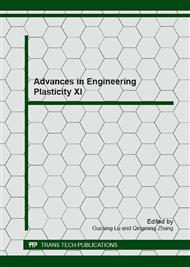p.449
p.453
p.457
p.461
p.465
p.469
p.473
p.477
p.481
Compressive Behavior of Luffa Sponge Material at High Strain Rate
Abstract:
The strain rate effect of luffa sponge material is an indispensable property for it to be used for acoustic, vibration, and impact energy absorption. Compressive tests at different strain rates on cylindrical column specimens of luffa sponge material were conducted over a wide density ranging from 24 to 64 kg/m3. A photographic technique was applied to measure the section area of the specimen with irregular shape. The mechanical properties of luffa sponge material at various strain rates were obtained based on this measurement. The dynamic data were compared to those of quasi-static experiments. It was found that compressive strength, plateau stress and specific energy absorption of luffa sponge material were sensitive to the rate of loading. Empirical formulae were developed for strength, densification strain and specific energy absorption at various strain rates in the macroscopic level by considering the luffa fiber as base material.
Info:
Periodical:
Pages:
465-468
Citation:
Online since:
January 2013
Authors:
Keywords:
Price:
Сopyright:
© 2013 Trans Tech Publications Ltd. All Rights Reserved
Share:
Citation:


